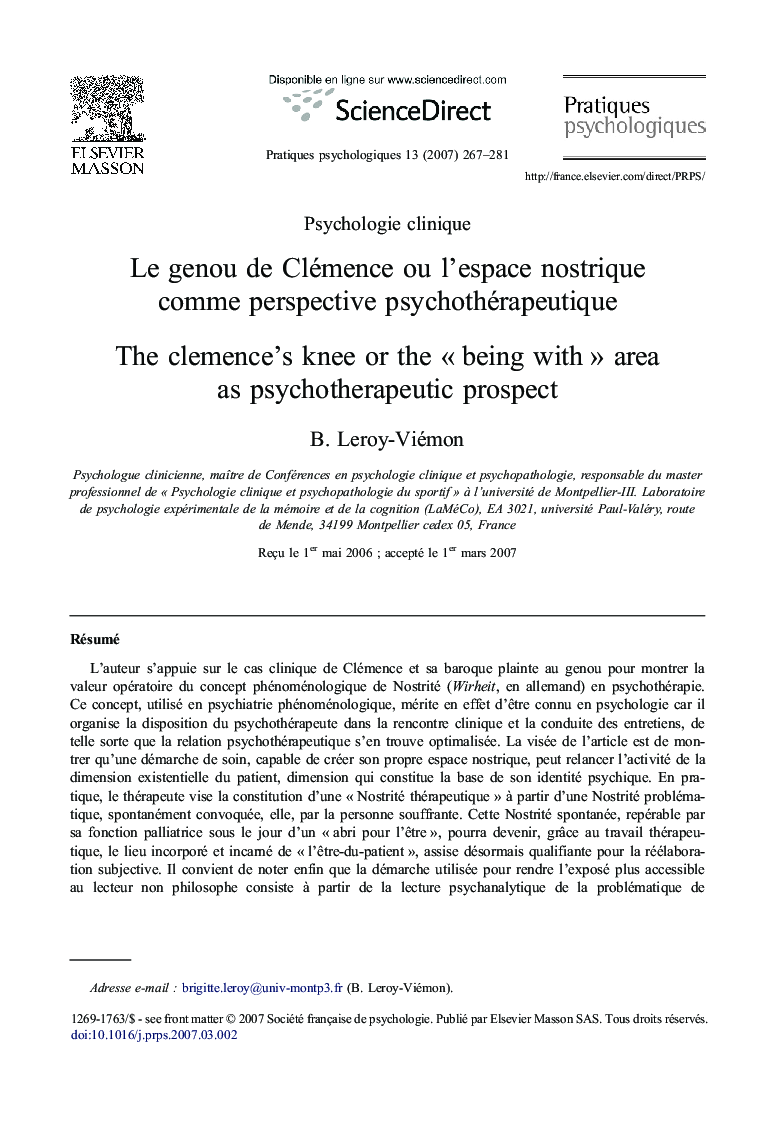| کد مقاله | کد نشریه | سال انتشار | مقاله انگلیسی | نسخه تمام متن |
|---|---|---|---|---|
| 893830 | 914443 | 2007 | 15 صفحه PDF | دانلود رایگان |

RésuméL'auteur s'appuie sur le cas clinique de Clémence et sa baroque plainte au genou pour montrer la valeur opératoire du concept phénoménologique de Nostrité (Wirheit, en allemand) en psychothérapie. Ce concept, utilisé en psychiatrie phénoménologique, mérite en effet d'être connu en psychologie car il organise la disposition du psychothérapeute dans la rencontre clinique et la conduite des entretiens, de telle sorte que la relation psychothérapeutique s'en trouve optimalisée. La visée de l'article est de montrer qu'une démarche de soin, capable de créer son propre espace nostrique, peut relancer l'activité de la dimension existentielle du patient, dimension qui constitue la base de son identité psychique. En pratique, le thérapeute vise la constitution d'une « Nostrité thérapeutique » à partir d'une Nostrité problématique, spontanément convoquée, elle, par la personne souffrante. Cette Nostrité spontanée, repérable par sa fonction palliatrice sous le jour d'un « abri pour l'être », pourra devenir, grâce au travail thérapeutique, le lieu incorporé et incarné de « l'être-du-patient », assise désormais qualifiante pour la réélaboration subjective. Il convient de noter enfin que la démarche utilisée pour rendre l'exposé plus accessible au lecteur non philosophe consiste à partir de la lecture psychanalytique de la problématique de Clémence pour aller progressivement vers une compréhension phénoménologique de celle-ci. De telle sorte que se dégage, par différence, l'apport tant théorique que pratique du concept de Nostrité pour notre discipline.
The writer uses the case study of Clemence' knee to present the phenomenological concept of Wirheit in german (Nostrité in french) which can be translate into "being with" or "being together" in english. This concept is worth knowing in psychology because it can run the psychotherapeutic treatment more effective: care proceedings which will be able to create their own "being with" area vill start again the existential dimension of the patient; this sentient and unrepresentable (so unanalysable) base of the psychical human identity. In practice, we'll see that this therapeutic « being with » consists in working a spontaneous problematic "being with" called out by the patient. This defensive position can be identified in the light of a cover for the human being core. With the therapeutic help, such a "being with" will become the place of the embodied and incorporated self as a competent base for existence. It is noteworthy that the method used to make the reader's understanding easier is to start from a psychanalytic understanding of Clemence's problematic to move on a phenomenological one, so as to draw the efficient sight, for psychology, of this "being with" concept came from philosophy.
Journal: Pratiques Psychologiques - Volume 13, Issue 3, September 2007, Pages 267–281